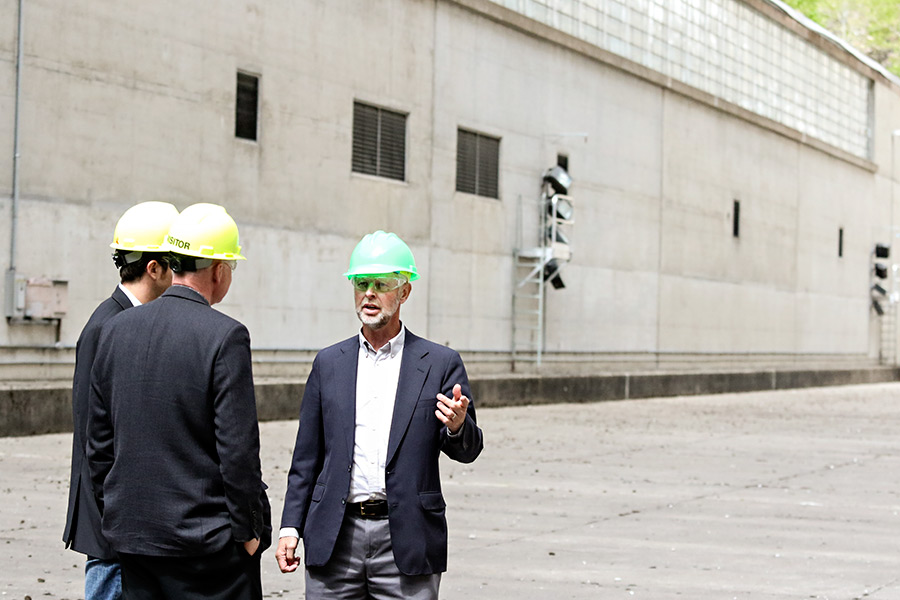Energy Committee Visits the Flathead
Lawmakers tour the valley’s diverse profile of renewable energy production to help inform legislation
By Tristan Scott
Hydro. Solar. Biomass. Gas.
The Flathead Valley’s renewable energy profile includes cutting-edge examples of all four resources, and state lawmakers took advantage of their proximity this week when the Legislature’s Energy and Telecommunications Interim Committee converged here for a tour of the local facilities.
Rep. Keith Regier, R-Kalispell, is chairman of the interim committee, and said while it’s rare for committees to leave Helena, the Flathead serves as a strong example of energy innovation working in concert with traditional resources, and the tour offered a chance to illuminate challenges and harness opportunities to better develop energy efficiency.
The group of more than a dozen committee members consisting of lawmakers and staff included other stakeholders, who paid visits to the Hungry Horse Dam, the F.H. Stoltze Land and Lumber Co.’s biomass co-generation facility in Columbia Falls, and Flathead Electric Co-op’s community solar and gas-to-energy landfill projects.
In October 2013, Stoltze unveiled its $22 million co-generation plant, which uses wood waste to heat the company’s mill, dry its wood and produce enough electricity for about 2,500 homes.
The Stoltze biomass plant could potentially be a model for mills across the region as it produces clean power from a renewable resource – trees.
The project was made possible with cooperation from the U.S. Forest Service, the Montana Department of Natural Resources and Conservation, Flathead Electric Cooperative, the Bonneville Power Administration and others.
In a rare tour, the ETIC also visited the generating units in the power plant at Hungry Horse Dam, where the U.S. Bureau of Reclamation is examining options for massive upgrades to the units, which have been in service since the dam opened in 1953.
The bureau is conducting an environmental assessment on an estimated $200 million in upgrades to the dam that will likely take at least a decade, according to facility manager Dennis Philmon and support service supervisor Prudence Crampton, who led lawmakers on a special tour of the facility May 12.
It’s the largest project undertaken on the dam since it opened and will likely include the replacement of its four turbines, as well as maintenance to the dam’s penstocks and selective withdrawal system, and maintenance to its outlet works tubes and spillway.
If all goes as planned, work could begin in 2017, Philmon said, adding that some of the units are reaching the end of their life expectancy.
The Bonneville Power Administration would cover the costs to modernize the facility.
Montana Fish, Wildlife and Parks, the U.S. Fish and Wildlife Service and Glacier National Park have expressed support, but consideration is being given to potential negative impacts to downstream aquatic life, including westslope cutthroat trout and threatened bull trout.
Brian Marotz, the state agency’s hydropower mitigation coordinator, said dam operations in the past have been upgraded to meet the needs of sensitive species.
Specifically the installation more than two decades ago of a selective withdrawal system to warm downstream waters to natural temperatures, which improved aquatic productivity and boosted trout numbers.
On May 13, ETIC members visited Flathead Electric’s landfill gas-to-energy plant – the first of its kind in Montana.
Flathead Electric Cooperative’s landfill gas-to-energy project has become a bright spot in the utility company’s effort to create a renewable energy portfolio, showing that even a relatively small outfit can develop alternative energy resources.
The process of turning garbage into energy is simple.
When organic waste in a landfill decomposes, it naturally emits methane gas, and county landfills are required to collect that gas to prevent it from leeching into the groundwater. To dispose of the gas, they typically burn it off in a flare.
But like wind and solar power, the gas can also be harnessed for use as an energy source, which is accomplished by drilling a series of collection wells into the landfill.
Continuous supply of this gas means that landfill gas-to-energy plants can operate virtually non-stop, providing a reliable energy supply.
The committee wrapped up its energy tours with a visit to Flathead Electric’s Solar Utility Network, or SUN project.
In a valley with notoriously gray skies, solar-powered energy might not seem like the most reliable energy source. But the cooperative’s solar array allows its members to purchase panels and receive a credit on their bill for the amount of electricity generated at their panel.
The SUN project dovetailed with ETIC’s study of net metering, which attempts to address questions raised by renewable energy organizations and utilities about the use of community solar across Montana.
Stacy Schnebel, who serves on Flathead Electric Cooperative’s Board of Trustees and joined lawmakers on the tour, said she owns a panel and was pleased that the Flathead Valley could showcase its alternative energy resources to legislators.
While in the Flathead, the ETIC also continued to review its proposed next-generation 9-1-1 report, and discussed three pieces of proposed legislation aimed at updating Montana’s 9-1-1 laws to enhance public safety in Montana.